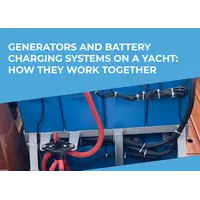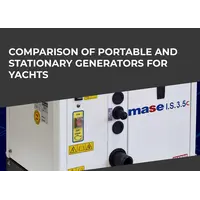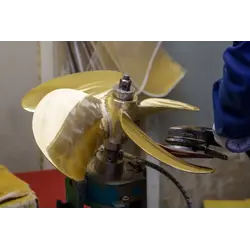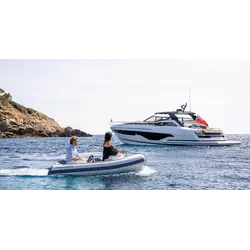On yachts, fishing boats and other vessels, specialized marine batteries are usually used. In this article we will talk about their application, what you should pay attention to when choosing a battery, how boat batteries differ from car batteries, their specialization and types of operation, as well as their varieties in terms of chemical composition.
Batteries are required for autonomous power supply of the outboard electric motor, navigation instruments, lighting devices and other electrical equipment on various boats. Before choosing and purchasing batteries, it is worth determining for what purposes and with what frequency it will be used on the boat, what type of motor is installed on it, whether other functions besides starting the engine will be assigned to the battery.
When driving, strong pitching and roll of the motor boat, as well as splashes on the equipment are possible. Therefore, the batteries that ensure the operation of the engine must be resistant to vibrations, mechanical damage and high humidity, and also, they better not be afraid of deep discharges. Important parameters when choosing a battery for a boat electric motor are:
- the presence of an electric motor, as well as the mass of the boat;
- battery capacity, since the battery life of the electric motor and additional equipment on a single battery charge depends on them;
- maintenance requirements - sealed maintenance-free batteries are probably the best choice in this category;
- the ability to work with strong pitching, the ability to function in a wide temperature range;
- self-discharge level - it should be minimal to eliminate the risk of deep discharge of the battery during storage.
- voltage - it can be 12, 24, 36 or 48 volts;
- weight and dimensions of the battery - the lighter and more compact the battery, the more convenient it is to use;
- ease of transportation and storage, safety of use, fitting for the current water area, vacation style or fishing conditions.
The Difference Between a Marine Battery for a Boat and a Regular Battery
Batteries in small boats are not used in the same way as in cars. On powerboats and sailing yachts, batteries are discharged more deeply. Trying to apply automotive experience to boat batteries results in batteries only lasting 1-2 years before losing capacity and failing. Some fishermen or small boat owners often opt for car batteries in the beginning to save money, but as practice shows, the lower price is not justified.
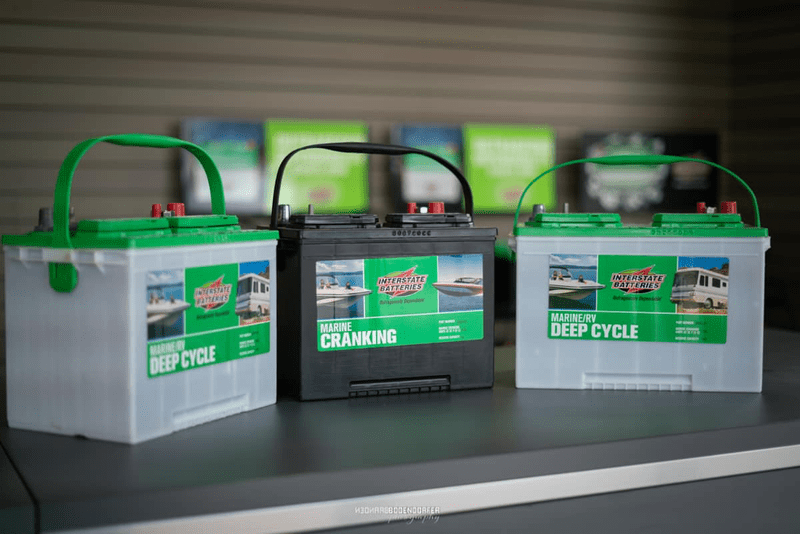
Automotive batteries are starter-type power supplies designed to supply short-term starting current. When used as directed, they will last for years. But when they are used in continuous DC mode and brought to deep discharges, car batteries quickly become unusable.
How long a car battery lasts depends on the intensity of its use. Typically, a new battery lasts half a season or a whole season, most often in the range of five to seven charge cycles. Therefore, it is worth using a car battery only in combination with an engine, running on fuel. And the electric motor needs a traction battery or a universal dual-use model.
In essence, the electrochemical processes of marine batteries are almost no different from "land" ones, but they have their own characteristics. Modern marine batteries almost always have a so-called double terminal. That is, traditional cone terminals are duplicated with studs. This is done in order to be able to quickly connect an additional load. To provide increased vibration resistance, the plates are also stuffed in a slightly different way. They also have a special rating system for output energy in amperes and charge cycles.
Marine Battery Types
When choosing a battery, it is necessary to focus not only on the size, capacity and brand that represents it. It is necessary to clearly understand the purpose of the battery and its scope. At the moment, three types of batteries are widely used when completing boats and other watercraft: marine starting batteries, marine deep cycle batteries and marine dual-purpose batteries. Let's dwell on each of them in more detail.
Marine Starting Batteries
Boats with internal combustion engines are traditionally equipped with such batteries. They provide a quick start of a diesel or gasoline engine, their task is to generate a current of 500-1000 amperes within 5-10 seconds, which allows you to start the engine. They are designed only for such short-term supply of high currents and should not be operated in a continuous output mode, such as powering a trolling motor or electrical equipment. Under prolonged loads, starting batteries quickly lose their charge and fail prematurely.
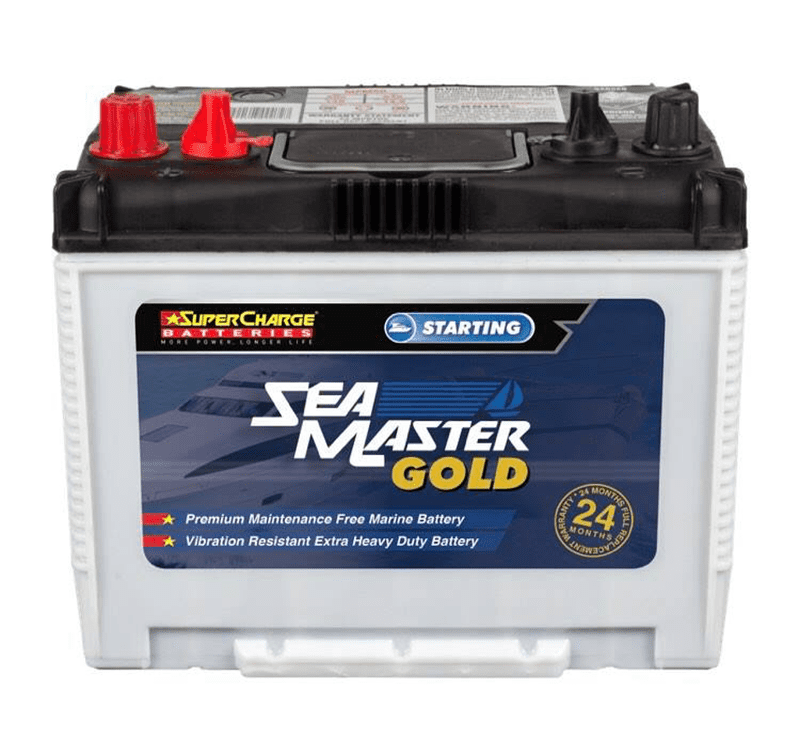
Deep discharge for this type of battery is a situation where too much battery power is used up in a short time – then the battery loses about half of its capacity.
Marine Deep Cycle Batteries
This type of battery is designed for stable cyclic operation in charge-discharge mode. They are designed for long-term use, give off the maximum of accumulated energy, provide a stable current and resist oxidation. Depending on their chemical composition, they withstand from 500 to 2000 operating cycles.
It is deep cycle batteries that are designed for intensive use in constant mode and frequent deep discharges. It is a good choice for powering outboard electric motors on PVC boats and fishing boats, they never self-discharge and also endure dynamic vibrations.
They are also able to provide power to a variety of equipment on the yacht, such as a winch, energy-intensive on-board electronics, radars and depth gauges, lighting lights and thrusters. Although they are more expensive than their counterparts, they are unrivaled for cyclic and heavy-duty use.
Marine Dual-Purpose Batteries
One of the main tasks facing the developers of power sources for boats and boats is the successful combination of the positive properties of traction and starter batteries. Universal marine dual-purpose batteries are able to provide high starting current, as well as work as a deep-discharge power source in charge-discharge mode.
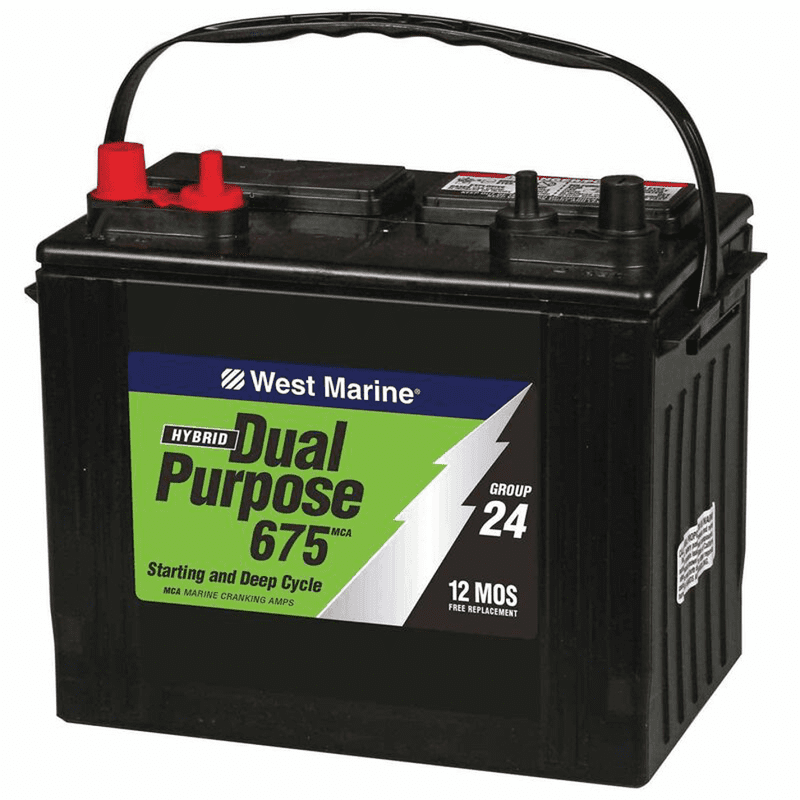
That is, they combine the properties of traction and starter batteries: they allow you to start the internal combustion engine, feed the electric motor and the entire power consumption system of the boat. But their weaknesses are also universal: some of them last far fewer cycles than typical deep cycle batteries, others do not provide enough power to start certain engines.
Marine Battery Types by Chemistry
According to their chemical composition and manufacturing technology, batteries for boat electric motors are of several types:
- Wet lead acid (WET) are serviceable workhorses. They are inexpensive, frost-resistant, withstand up to 1000 operating cycles, and have good initial capacity. But they must be transported and used strictly in an upright position, and charged in well-ventilated rooms. Traction type models are manufactured using thicker plates and special anti-oxidation additives. However, in terms of ease of use, they are inferior to competitors, and if they are often discharged, then part of the capacity will be lost.
Created by AGM technology - models with absorbed electrolyte. AGM lead-based battery technology involves the use of absorbed fiberglass. It is produced without the use of liquid - using pressed fiberglass of a cellular structure, due to which it does not require maintenance, since it is not necessary to fill in the electrolyte. Due to the minimal addition of acid, the risk of sulfation of the electrodes is practically minimized.
They are safe and easy to use, operate over a wide temperature range, are vibration resistant and can be tilted or flipped on their side. But such batteries are afraid of deep discharges, so they are not recommended for use in cyclic mode. Their resource usually does not exceed 400 cycles.
-
Gel (GEL) - sealed, maintenance-free deep-cycle batteries. This is the second sub-type of lead-based battery used with electric outboard motors. By design, these are sealed, maintenance-free batteries in which the electrolyte is in the form of a gel, which prevents the risk of leakage.
Such models are well suited for the use of boat electric motors. Gel batteries are not afraid of deep discharge, can withstand up to 700 operating cycles, can produce a high starting current when starting the motor, can be turned over, and work seamlessly at both low and high temperatures. When idle, they are able to quickly restore the original resource.
GEL batteries are superior in performance to WET and AGM types, but they cannot be recharged.
-
Lithium-ion (Li-ion) batteries are maintenance-free batteries with high energy density, light and easy to use. They are reliable, meet high safety requirements, withstand up to 1000 operating cycles, have a wide temperature range and low self-discharge. They charge quickly and require no maintenance.
They have a protection board against all kinds of risks during operation. The category of batteries includes models with different chemical composition. Manufacturers are experimenting with the composition of the cathode and anode, creating batteries with different technical characteristics - different values of capacity, voltage, current loads and cyclic life.
It is also worth paying attention to lithium-iron-phosphate (LiFePO4) batteries - a subspecies of lithium-ion. Working resource - more than 2000 cycles. These are traction type batteries with high energy intensity, thermal and chemical stability.
Marine Battery Group Size
The marine battery group size chart refers to physical dimensions, it is presented by battery length, width and height, as well as C-rate, and cranking amps. This sizing system was created by the Battery Council International to standardize the industry.
| Group Size | Lenght, " | Width, " | Height, " | Ah (Capacity) | Estimated CAA |
|---|---|---|---|---|---|
| 22NF | 9.43 | 5.5 | 8.94 | 40-56 | 300-550 |
| 24M | 10.25 | 6.81 | 9.75 | 75-85 | 500-840 |
| 25 | 9.06 | 6.88 | 8.88 | - | - |
| 27M | 12.5 | 6.81 | 9.75 | 66-110 | 640-870 |
| 31M | 13 | 6.81 | 9.44 | 75-125 | 600-1150 |
| 34M | 10.25 | 6.81 | 9.44 | 50-75 | 750-880 |
| 35 | 9.06 | 6.88 | 8.88 | - | - |
| 65 | 12.06 | 7.56 | 7.56 | - | - |
When you decide, for example, to purchase a group 25 battery, you know exactly the size you are buying. Regardless of the battery manufacturer, the group size is a standard value that can be trusted. Boat manufacturers use the same dimensions when installing pallets or battery compartments.



